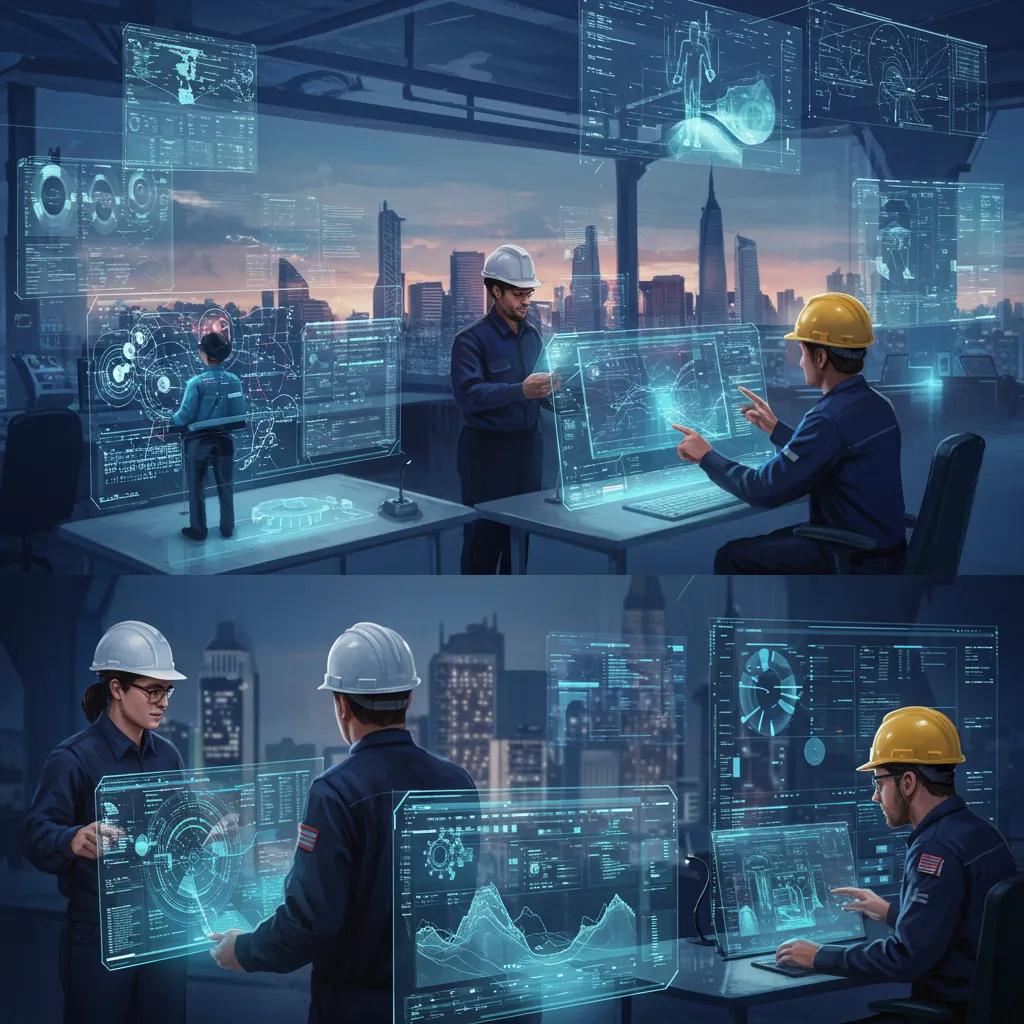Navigating the Digital Engineering Revolution: USA Market Insights, Technologies, and Impact
The digital engineering landscape in the USA is set to surge past $1.5 trillion by 2025, signaling a profound transformation in how products are conceived, developed, and managed. This shift is powered by simulation, automation, and real-time data analytics. This guide offers a clear path for engineering leaders grappling with the complexities of integrating AI, IoT, cloud, and modern web technologies. Explore the key catalysts for growth, groundbreaking technologies, industry-wide impacts, and the latest trends in the USA’s web engineering sector—and discover how we empower organizations to thrive in this digital era by crafting robust online solutions.
Digital Engineering Market to Reach $1.6 Trillion by 2026
What’s Fueling the Surge in USA Digital Engineering?
The expansion of digital engineering is propelled by the synergy of advanced analytics, live sensor data, and scalable cloud infrastructure, all of which accelerate innovation and shorten delivery timelines. Government backing, increased R&D investments, and a highly skilled workforce further amplify this growth. Key drivers include:
- Simulation tools that replace physical prototypes, drastically cutting development timelines.
- AI-driven optimization tools that refine design precision.
- IoT-powered monitoring systems that ensure peak operational performance.
Collectively, these elements enhance competitive edge and pave the way for deeper integration of AI and IoT into engineering workflows.
How Is Digital Engineering Revolutionizing Product Development?
Digital engineering fundamentally reshapes product development by enabling virtual prototyping, collaborative model-based systems engineering, and continuous feedback loops. This approach slashes physical testing expenses and speeds up design iterations. Key transformations include:
- Virtual Twins – Craft digital replicas to rigorously test performance before production.
- Collaborative Hubs – Synchronize global teams in real-time for swift decision-making.
- Automated Checks – Run extensive simulations overnight to pinpoint design flaws.
These capabilities lead to superior design quality and faster market entry, setting the stage for sophisticated AI applications.
What’s AI’s Role in American Engineering?

Artificial Intelligence is making engineering smarter by dissecting complex data, automating design refinements, and predicting maintenance needs, thereby boosting reliability and reducing costs. Core AI functions include:
- Generative Design – AI models propose optimized structural designs.
- Predictive Maintenance – Machine learning algorithms forecast potential equipment failures.
- Quality Assurance – Computer vision systems meticulously detect defects.
Integrating AI with digital twins and IoT further amplifies operational insights and accelerates innovation cycles.
How Is the Internet of Things Elevating Engineering Solutions?

The Internet of Things enhances engineering by connecting sensors to cloud platforms for real-time data capture, enabling proactive maintenance and process optimization. Key applications include:
- Remote Oversight – Monitor the health of assets across various locations.
- Resource Management – Automate the tracking of inventory and usage.
- Digital Twin Synchronization – Feed live operational data into virtual models.
This interconnected approach boosts productivity and reliability, laying the groundwork for the next wave of digital advancement.
What Are the Cutting-Edge Trends in AI and Agentic AI for Engineering in the USA?
Agentic AI—intelligent software agents capable of self-directed task execution—is emerging alongside generative AI and machine learning to dramatically enhance engineering efficiency and creativity. These advancements promise faster design cycles, autonomous operations, and proactive maintenance strategies. Together, these innovations unlock unprecedented levels of productivity and resource optimization, propelling the digital engineering market forward.
U.S. Firms Accelerate Digital Engineering with Generative and Agentic AI
These combined innovations unlock new levels of productivity and resource utilization, driving the digital engineering market upward.
How Is Generative AI Reshaping Engineering Design?
Generative AI is redefining engineering design by exploring vast possibilities to propose novel structures and materials, thereby shortening design loops and enhancing performance. For instance:
- Topology Optimization – Suggests material configurations for maximum strength with minimal weight.
- Constraint-Driven Design – Generates multiple design options that meet specific requirements.
- Rapid Concept Generation – Delivers a multitude of design concepts in mere minutes.
Generative approaches foster creativity and efficiency, creating a foundation for agentic systems to manage more complex tasks.
What Are the Applications of Agentic AI in Engineering Tasks?
Agentic AI applications autonomously handle scheduling, resource allocation, and simulation workflows, freeing up engineers to concentrate on strategic initiatives and innovation. Common use cases include:
- Project Planning Agents – Automatically create project timelines and resource allocations.
- Code Generation Assistants – Produce foundational code for simulation scripts.
- Automated Testing – Execute test suites and flag any discrepancies.
By delegating routine tasks, agentic AI significantly boosts productivity and accelerates project completion.
How Is Machine Learning Enhancing Predictive Maintenance?
Machine learning optimizes predictive maintenance by analyzing data from vibrations, thermal sensors, and usage patterns to identify potential issues before they lead to failure, thereby extending equipment lifespan and minimizing downtime. Key ML techniques include:
- Anomaly Detection – Pinpoints sensor readings that deviate from normal parameters.
- Trend Analysis – Learns patterns of wear and tear over time.
- Failure Probability Modeling – Assesses the likelihood of component failure.
These insights enable scheduled maintenance and cost savings, reinforcing the reliability of critical systems.
How Are IoT Solutions Transforming the Engineering Sector in the USA?
IoT solutions are revolutionizing operations by channeling device data into advanced analytics and digital twins, leading to more informed decisions and adaptive control systems. Leading applications include:
- Smart Manufacturing – Coordinates robots and assembly lines for seamless production flows.
- Infrastructure Oversight – Monitors the structural integrity of bridges and buildings.
- Energy Optimization – Manages and reduces energy consumption across facilities.
This interconnectedness forms the backbone of the digital engineering ecosystem, promoting resilience and agility.
What Are the Advantages of IoT in Smart Manufacturing and Infrastructure?
IoT provides real-time visibility, automated control, and predictive insights that drive efficiency and safety in manufacturing and infrastructure projects.
These benefits accelerate production, optimize asset utilization, and establish the foundation for integrated digital twins.
How Do IoT Platforms Facilitate Real-Time Data Analytics?
IoT platforms consolidate and process sensor data streams at the edge and in the cloud, delivering immediate insights that guide proactive responses. Key enablers include:
- Edge Computing Units – Process and filter data locally.
- Scalable Cloud Analytics – Apply machine learning models to aggregated data.
- Event-Driven Notifications – Trigger alerts when predefined thresholds are crossed.
This architecture converts raw data into actionable intelligence, enhancing system uptime and performance.
What Hurdles Exist in Merging IoT with Digital Engineering?
Integrating IoT with digital engineering presents challenges such as incompatible protocols, fragmented data, and security vulnerabilities, which complicate unified operations. Common obstacles:
- Interoperability Issues – Older equipment often uses proprietary connections.
- Data Consolidation – Merging diverse data formats into a cohesive model.
- Cybersecurity Risks – Protecting connected devices from potential threats.
Overcoming these challenges necessitates standardization and robust security measures to enable seamless digital collaboration.
What Is the Impact of Digital Transformation on USA Engineering Firms?
Digital transformation fundamentally reshapes processes, organizational culture, and business strategies by integrating AI, IoT, and cloud services across all engineering phases, fostering resilience and creating new revenue streams. Key impacts of this transformation include:
- Agile Collaboration – Eliminates silos through integrated platforms.
- Data-Informed Decisions – Leverages analytics for strategic planning.
- Performance-Based Services – Shifts focus from product sales to ongoing operational value.
These strategic shifts enable firms to innovate continuously and maintain a competitive edge in a dynamic market.
How Does Cloud Computing Empower Engineering Innovation?
Cloud computing fuels innovation by providing scalable compute power, storage, and simulation environments on demand, accelerating experimentation and teamwork. Key cloud advantages:
- On-Demand Labs – Set up testing environments in minutes.
- Centralized Repositories – Store CAD files and datasets in a single location.
- Simulation-as-a-Service – Conduct large-scale analyses without needing on-premises hardware.
This flexibility allows teams to scale R&D efforts rapidly and cost-effectively.
Why Is Cybersecurity Paramount for Digital Engineering?
Cybersecurity is essential for protecting intellectual property, operational data, and control systems from breaches, ensuring trust and adherence to regulations. Core security measures include:
- Network Segmentation – Isolates critical systems from general networks.
- Access Control – Enforces minimal necessary permissions for tools and data.
- Threat Monitoring – Detects anomalies and responds to security incidents.
Robust security defenses maintain system integrity, enabling secure digital collaboration and innovation.
How Are Business Models Evolving Through Digital Transformation?
Business models are shifting from one-time transactions to subscription, platform, and outcome-based offerings, generating predictable revenue and fostering deeper client relationships. Emerging model characteristics:
- Digital Twins as a Service – Provide continuous performance monitoring.
- XaaS Subscriptions – Bundle software, analytics, and support services.
- Performance-Based Agreements – Structure contracts around metrics like uptime or output.
This evolution aligns business objectives with client success and cultivates long-term partnerships.
What Are the Current Trends in the USA Web Development Market for Engineering?
The USA web development market catering to engineering is valued at over $18 billion, growing at a 5 percent CAGR, driven by the demand for interactive dashboards, collaborative tools, and sophisticated client portals.
U.S. Web Development Market Valued at $18.25 Billion with 5.15% CAGR
Key trends include:
- Single-Page Applications – Offer seamless, desktop-like experiences within web browsers.
- Progressive Web Apps – Provide offline capabilities and native app-like performance.
- Headless CMS – Decouple content management from the front-end presentation layer.
These advancements facilitate real-time collaboration and data visualization for engineering teams.
How Does Web Engineering Enhance Collaboration and User Experience?
Web engineering improves collaboration through integrated dashboards and intuitive interfaces, streamlining communication and decision-making processes. Core features include:
- Integrated Chat & Video – Enable immediate discussions around design elements.
- Version Control Dashboards – Display model revisions and associated feedback.
- Role-Specific Interfaces – Customize functionality for engineers, managers, and clients.
This user-centric approach boosts productivity and enhances stakeholder satisfaction across projects.
What Is the Role of Low-Code/No-Code Solutions in Engineering Web Development?
Low-code/no-code platforms accelerate web application development by providing visual, drag-and-drop interfaces and pre-built components, reducing development time and technical barriers. Typical advantages:
- Rapid Prototyping – Create functional prototypes in hours.
- Cost-Effectiveness – Minimize the need for highly specialized developers.
- Flexible Updates – Modify interfaces and logic without extensive coding.
These platforms democratize digital tool creation, empowering subject matter experts to build their own solutions.
How Is the Web Development Market Expanding in the USA?
The U.S. web development market is growing at approximately 5 percent annually, driven by substantial digital transformation budgets and a rising demand for real-time analytics portals. Growth drivers include:
- Increased R&D investments by engineering enterprises.
- Widespread adoption of cloud-native and microservices architectures.
- Strong demand for custom dashboards and client engagement platforms.
This upward trajectory underscores the strategic importance of web engineering services—and highlights how we assist organizations in capitalizing on these opportunities by delivering scalable, secure, and user-centric digital solutions.
Engineering firms and technology partners that embrace these evolving trends will unlock accelerated innovation, optimized operations, and enhanced customer value within the dynamic digital engineering landscape.


